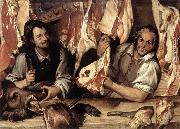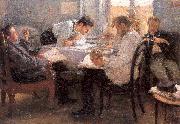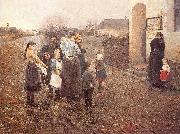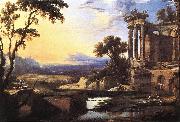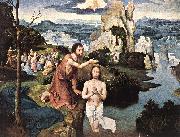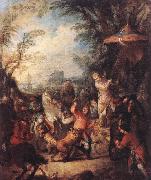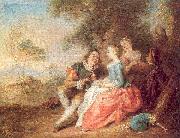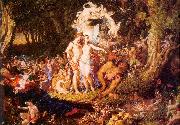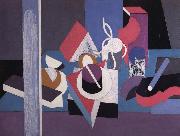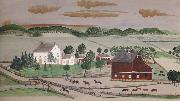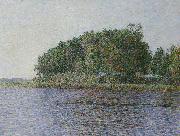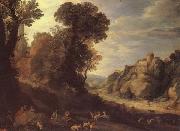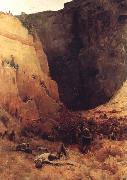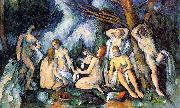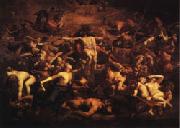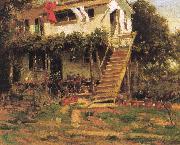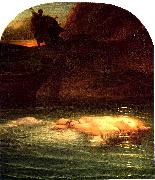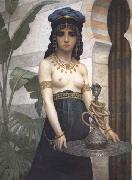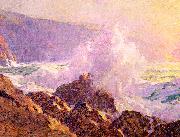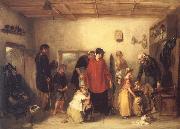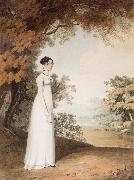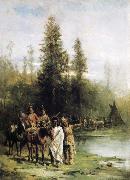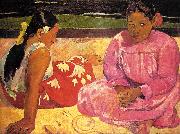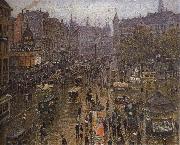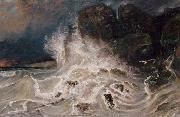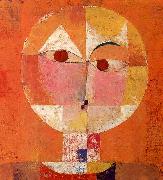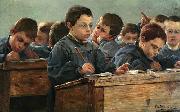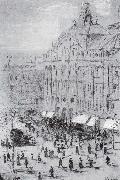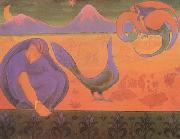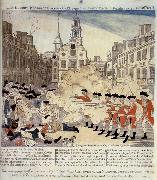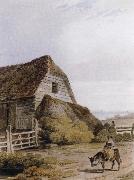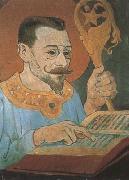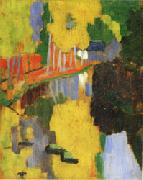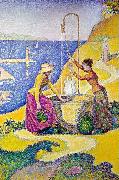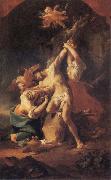|
|
|
|
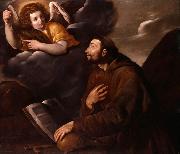 |
Pasquale Ottino
|
|
(Verona, 1578 - Verona, 1630) was an Italian painter.
Born in Verona in 1578, Ottino learned his trade in the workshop of Felice Brusasorci together with Alessandro Turchi, known as Orbetto, with whom he completed the Fall of Manna in the church of San Giorgio in Braida, left unfinished on the masteres death in 1605. His early works attest to the decidedly Mannerist character of the initial phase of his career. The sources indicate fairly constant activity in his hometown, even though there are still some doubts as to the reconstruction of his artistic career, especially incongruities regarding a trip to Rome that may have taken place with his companions Turchi and Bassetti around 1615. He died of plague in Verona in 1630.
|
|
|
|
|
|
|
|
|
|
|
|
|
|
|
|
|
|
|
|
|
|
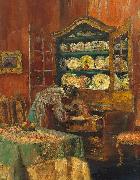 |
Paul Barthel
|
|
painted Interieur mit geoffneter Vitrine in 1862 - 1933 |
|
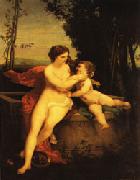 |
Paul Baudry
|
|
French Academic Painter, 1828-1886. Specializes in Portraits |
|
|
|
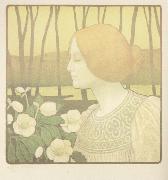 |
Paul Berthon
|
|
A truly gifted illustrator and poster artist ,
French , 1872-1909
|
|
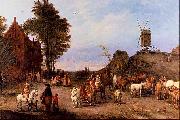 |
Paul Bril
|
|
Flemish Baroque Era Painter, ca.1554-1626 |
|
|
|
|
|
|
|
|
|
|
|
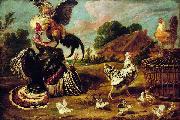 |
Paul de Vos
|
|
(1591e1592, or 1595, Hulst-30 June 1678, Antwerp) was a Flemish Baroque painter.
De Vos was born in Hulst near Antwerp, now in the Dutch province of Zeeland. Like his older brother Cornelis and younger brother Jan, he studied under the little-known painter David Remeeus (1559-1626). He specialized in monumental animal scenes, especially hunts for aristocratic patrons, that are heavily influenced by Frans Snyders (to whom his sister Margaretha was married). De Vos became a master and joined the guild of St. Luke in 1620.
As was frequent amongst artists in Antwerp, De Vos frequently collaborated with other painters. He painted animals in hunting scenes and armor in mythologies by Peter Paul Rubens and his studio. He also worked with Thomas Willeboirts Bosschaert, Erasmus Quellinus II, Anthony van Dyck, and Jan Wildens.
|
|
|
|
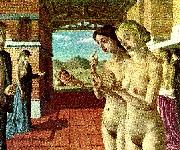 |
paul delvaux
|
|
Delvaux was born in Antheit in the Belgian province of Liege, the son of a lawyer. The young Delvaux took music lessons, studied Greek and Latin, and absorbed the fiction of Jules Verne and the poetry of Homer. All of his work was to be influenced by these readings, starting with his earliest drawings showing mythological scenes. He studied at the Academie Royale des Beaux-Arts in Brussels, albeit in the architecture department owing to his parents' disapproval of his ambition to be a painter. Nevertheless, he pursued his goal, attending painting classes taught by Constant Montald and Jean Delville. The painters Frans Courtens and Alfred Bastien also encouraged Delvaux, whose works from this period were primarily naturalistic landscapes. He completed some 80 paintings between 1920 and 1925, which was the year of his first solo exhibition.
Delvaux's paintings of the late 1920s and early 1930s, which feature nudes in landscapes, are strongly influenced by such Flemish Expressionists as Constant Permeke and Gustave De Smet. A change of style around 1933 reflects the influence of the metaphysical art of Giorgio de Chirico, which he had first encountered in 1926 or 1927. In the early 1930s Delvaux found further inspiration in visits to the Brussels Fair, where the Spitzner Museum, a museum of medical curiosities, maintained a booth in which skeletons and a mechanical Venus figure were displayed in a window with red velvet curtains. This spectacle captivated Delvaux, supplying him with motifs that would appear throughout his subsequent work. In the mid-1930s he also began to adopt some of the motifs of his fellow Belgian Rene Magritte, as well as that painter's deadpan style in rendering the most unexpected juxtapositions of otherwise ordinary objects.
Delvaux acknowledged his influences, saying of de Chirico, "with him I realized what was possible, the climate that had to be developed, the climate of silent streets with shadows of people who can't be seen, I've never asked myself if it's surrealist or not." Although Delvaux associated for a period with the Belgian surrealist group, he did not consider himself "a Surrealist in the scholastic sense of the word." As Marc Rombaut has written of the artist: "Delvaux ... always maintained an intimate and privileged relationship to his childhood, which is the underlying motivation for his work and always manages to surface there. This 'childhood,' existing within him, led him to the poetic dimension in art."
The paintings Delvaux became famous for usually feature numbers of nude women who stare as if hypnotized, gesturing mysteriously, sometimes reclining incongruously in a train station or wandering through classical buildings. Sometimes they are accompanied by skeletons, men in bowler hats, or puzzled scientists drawn from the stories of Jules Verne. Delvaux would repeat variations on these themes for the rest of his long life, although some departures can be noted. Among them are his paintings of 1945-47, rendered in a flattened style with distorted and forced perspective effects, and the series of crucifixions and deposition scenes enacted by skeletons, painted in the 1950s.
In the late 1950s he produced a number of night scenes in which trains are observed by a little girl seen from behind. These compositions contain nothing overtly surrealistic, yet the clarity of moonlit detail is hallucinatory in effect. Trains had always been a subject of special interest to Delvaux, who never forgot the wonder he felt as a small child at the sight of the first electric trams in Brussels. |
|
|
|
|
|
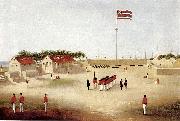 |
Paul Emmert
|
|
Paul Emmert (1826-1867) , who is also known as Paul Emert, was an artist born near Berne, Switzerland in 1826. By 1845, he had become an established artist in New York. He joined the gold rush to California in 1849. The following year he exhibited in Brooklyn a panorama of the gold mining activities before making his second trip to California late in 1850. While in California, he operated the Bear Hotel in Sacramento and exhibited the panorama in San Francisco and other communities. In 1853 he moved to Hawaii where he resided until his death in 1867 in Honolulu.
|
|
|
|
|
|
|
|
|
|
|
|
|
|
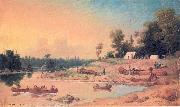 |
Paul Kane
|
|
(September 3, 1810 - February 20, 1871) was an Irish-born Canadian painter, famous for his paintings of First Nations peoples in the Canadian West and other Native Americans in the Oregon Country.
A largely self-educated artist, Kane grew up in Toronto (then known as York) and trained himself by copying European masters on a study trip through Europe. He undertook two voyages through the wild Canadian northwest in 1845 and from 1846 to 1848. The first trip took him from Toronto to Sault Ste. Marie and back. Having secured the support of the Hudson's Bay Company, he set out on a second, much longer voyage from Toronto across the Rocky Mountains to Fort Vancouver and Fort Victoria in the Columbia District, as the Canadians called the Oregon Country. |
|
|
|
|
|
|
|
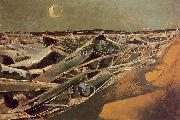 |
Paul Nash
|
|
British
1889-1946
Paul Nash Location |
|
|
|
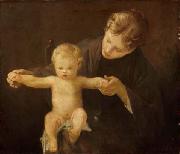 |
Paul Peel
|
|
(7 November 1860 - 3 October 1892) was a Canadian academic painter. Having won a medal at the 1890 Paris Salon, he became one of the first Canadian artists to receive international recognition in his lifetime.
Peel was born in London, Ontario, and received his art training from his father from a young age. Later he studied under William Lees Judson and at the Pennsylvania Academy of the Fine Arts under Thomas Eakins. He later moved to Paris, France where he received art instruction at the Ecole des Beaux-Arts under Jean-Leon Gerôme and at the Academie Julian under Benjamin Constant, Henri Doucet and Jules Lefebvre.
In 1882 he married Isaure Verdier and had two children with her: a son (Robert Andre, in 1886) and a daughter (Emilie Marguerite, in 1888).
Peel travelled widely in Canada and in Europe, exhibiting as a member of the Ontario Society of Artists and the Royal Canadian Academy. He also exhibited at international shows like the Paris Salon, where he won a bronze medal in 1890 for his painting After the Bath. He was known for his often sentimental nudes and for his pictures of children. |
|
|
|
|
|
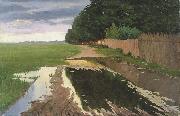 |
Paul Raud
|
|
(22 October 1865 in Kirikukela, Viru-Jaagupi Parish C 22 November 1930 in Tallinn) was an Estonian painter. The twin brother of painter Kristjan Raud, he studied in Desseldorf beginning in 1886, becoming influenced by the work of Eduard Gebhardt. After his return to Estonia, he painted mainly portrait commissions for some time, before traveling with his brother and Amandus Adamson to the islands of Muhu and Pakri in 1896. His works of this period are reminiscent of those of Max Liebermann. In 1899 he returned to work in Germany, taking on some of the stylistic trappings of Impressionism; this, coupled with time spent working with Ilya Repin, influenced his later style. Later in his career, most especially during and after World War I, he began to teach, from 1915 working as a drawing instructor at the Tallinn Institute of Commerce and from 1923 at the State School of Industrial Art in Tallinn.
|
|
|
|
|
|
|
|
|
|
|
|
|
|









